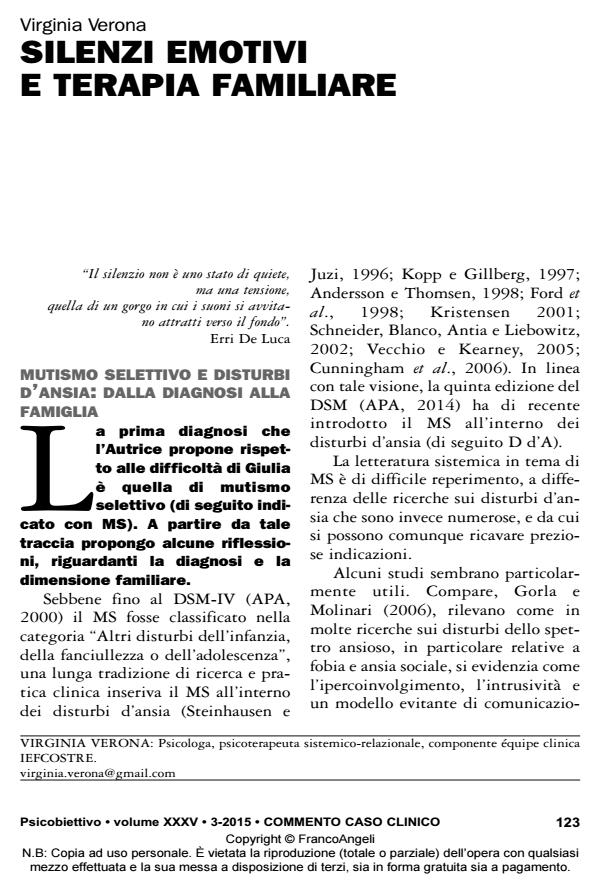Emotional silences and family therapy
Journal title PSICOBIETTIVO
Author/s Virginia Verona
Publishing Year 2016 Issue 2015/3
Language Italian Pages 7 P. 123-129 File size 91 KB
DOI 10.3280/PSOB2015-003009
DOI is like a bar code for intellectual property: to have more infomation
click here
Below, you can see the article first page
If you want to buy this article in PDF format, you can do it, following the instructions to buy download credits

FrancoAngeli is member of Publishers International Linking Association, Inc (PILA), a not-for-profit association which run the CrossRef service enabling links to and from online scholarly content.
From an examination of the literature that contextualises the symptoms of selective mutism and anxiety disorders with respect to family dynamics where they take form, one might suggest a possibility of systemic intervention in this particular clinical case. Considering the various bibliographic references, and the adoption of family resources as an aid to the difficulties of Giulia, the intervention should involve the participation of the whole family. The hypothesis could be to consider the symptoms of Giulia, of first silence, and afterwards tears, as highly significant, to be researched through a double path: on the one hand in the current family inter-relations and on the other, through examining the history that preceded and characterized Giulia’s family, eventually leading up to her current difficulties. The common thread of emotional dimension in the family dynamics, could well connect the two aspects of the therapeutic work, the structural one together with the narrative one.
Keywords: Selective Mutism; Anxiety Disorders; Family Therapy; Structural Intervention; Narrative Intervention; Emotional Dimension.
- American Psychiatric Association (2000) DSM-IV-TR, APA, Washington, DC (trad. it. DSM-IV-TR. Manuale diagnostico e statistico dei disturbi mentali. Quarta edizione. Text Revision, Masson, Milano, 2001)
- American Psychiatric Association (2014) DSM-5, Raffaello Cortina, Milano
- Andersson C.B., Thomsen P.H. (1998) “Electively mute children: an analysis of 37 danish cases”, Nord Journal of Psychiatry, 52: 231-238
- Bissoli C. (2003a) “Il mutismo selettivo”, in Isola L., Mancini F. (a cura di), Psicoterapia cognitiva dell’infanzia e dell’adolescenza, FrancoAngeli, Milano
- Bissoli C. (2007b) “Il mutismo selettivo”, in Isola L., Mancini F. (a cura di), Psicoterapia cognitiva dell’infanzia e dell’adolescenza, FrancoAngeli, Milano
- Boegels S.M., van Oosten A., Muris P., Smulders D. (2001) “Familial correlates of social anxiety in children and adolescents”, Behaviour Research & Therapy, 39: 273-287
- Bruch M.A., Heimberg R.G., Berger P., Collins T.M. (1989) “Social phobia and perceptions of early parental and personal characteristics”, Anxiety Research, 2: 57-65
- Capobianco M. (2009) “Il mutismo selettivo: diagnosi, eziologia, comorbilità e trattamento”, Cognitivismo Clinico, 6, 2: 211-228
- Compare A., Gorla C., Molinari E. (2006) “Famiglia e mutismo selettivo: aspetti relazionali e psicopatologici”, Psicologia Clinica dello Sviluppo, a. X, 2: 225-239
- Compare A., Gorla C., Molinari E. (articolo gentilmente concesso dall’autore nella versione precedente la stampa) “Mutismo selettivo e dinamiche relazionali familiari: rassegna internazionale delle ricerche e case report”
- Cunningham C.E., McHolm A.E., Boyle MH. (2006) “Social phobia, anxiety, oppositional behavior, social skills, and self concept in children with specific selective mutism, generalized selective mutism, and communuty controls”, European Child and Adolescent Psychiatry, 20: 1-11
- Dadds M.R., Marrett P.M., Rapee R.M. (1996) “Family process and child anxiety and aggression: An observational analysis”, Journal of Abnormal Child Psychology, 24: 715-734
- Fonagy P., Target M. (2001) Attaccamento e funzione riflessiva, Raffaello Cortina, Milano
- Ford M.A., Sladeczeck I.E., Carlson J., Kratochwill T.R. (1998) “Selective mutism: phenomenological characteristics”, School Psychology Quarterly, 13: 192-227
- Gorla C., Carminati M. (2011) “Mutismo selettivo: un intervento sistemico efficace”, Medico e Bambino pagine elettroniche, 14(7) http://www.medicoebambino.com/?id=CCO1107_10.html
- Hudson J.L., Rapee R.M. (2001) “Parent-child interactions and anxiety disorders: An observational study”, Behavior Research Therapy, 39: 1411-1427
- Hudson J.L., Rapee R.M. (2002) “Parent-child interactions in clinically anxious children and their siblings”, Journal of Clinical Child and Adolescent Psychology, 31: 548-555
- Kristensen H. (2001) “Multiple informants report of emotional and behavioural problems in a nation-wide sample of selective mute children and controls”, European Child & Adolescent Psychiatry, 10: 135-142
- Kopp S., Gilberg C. (1997) “Selective mutism: a population based study, a research note”, Journal Child Psychol Psychiatry, 38: 257-262
- Minuchin S. (1976) Famiglie e terapia della famiglia, Astrolabio, Roma Peleg-Popko O. (2002a) “Bowen Theory: A study o f differentiation of self, social anxiety, and physiological symptoms”,
- Contemporary Family Therapy, 24: 355-369
- Peleg-Popko O. (2002b) Children’s test anxiety and family interaction patterns, Anxiety, Stress & Coping, 15: 45-59
- Peleg-Popko O., Dar R. (2001) “Marital quality, family patterns, and children’s fears and social anxiety”, Contemporary Family Therapy, 23: 465-487
- Schneider F.R., Blanco C., Antia S.X., Liebowitz M.R. (2002) “The social
- anxiety spectrum”, Psychiatric Clinics of North America, 25: 757-774
- Steinhausen H.C., Juzi C. (1996) “Elective mutism: An analysis of 100 cases”, Journal of the American Academy of Child & Adolescent Psychiatry, 35: 606-614
- Vecchio J., Kearney C. (2005) “Selective mutism in children: a synopsis of characteristics, assessment and treatment”, Behavior Therapist, 29(5): 102-103
Virginia Verona, Silenzi emotivi e terapia familiare in "PSICOBIETTIVO" 3/2015, pp 123-129, DOI: 10.3280/PSOB2015-003009